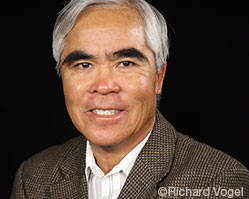
Nick Ut
2014 Honoree / Achievement In Photojournalism
Nick Ut became a combat photographer in Vietnam in 1966 after his older brother, Huynh Thanh My, was killed in 1965 while on assignment with the Associated Press. Ut always prays for his brother so he can help Ut and their family: they are Buddhists.
He covered Vietnam, Cambodia, and Laos during the Vietnam War. He covered endless tragic situations in front of his camera every day for most of the 10 years of conflict. Ut photographed the first human bodies in Mekong Delta in Vietnam at only 16-years-old.
On June 8, 1972, he traveled to the Trảng BàngVillage, where he saw thousands of Vietnamese refugees leaving their village. Black clouds of smog lingered from Southern Vietnamese bombs and early air strikes by the US. Ut took many pictures of refugees, fighting, and dead bodies at the Cao-Dai Buddhist Temple Pagoda as the South Vietnamese 25th Division came under heavy fire.
Upon leaving the site, a South Vietnamese A-37 Jet dropped four bombs, and a second airplane dropped four more. Ut stood less than one hundred yards away. He witnessed multiple victims: one woman with a wounded leg, another mother running with her children, and another grandmother carrying a one year old boy in her arms. The boy died right in front of many news media cameras. At the time, he had four cameras: two Nikon F’s and two Leicas (an M2, and an M3). He looked back at the black smoke at Pagoda and saw a little naked girl running at him screaming, “Too hot, too hot!”, and took a picture. The girl, Kim Phuc, ran with her brother, Tam Phuc, and her family. Ut took a few pictures and then put his camera on the ground of Highway 1 to give her drinking water and pour fresh water to cool off her body. Ut transported the girl to a nearby hospital where she received treatment for her wounds. To this day, Ut still remains close to Kim Phuc.
After getting Kim to the hospital, Ut went back to the Associated Press Saigon Bureau where he presented Kim’s photo to Horst Faas, the AP Saigon Photo Editor, and Peter Arnett, the AP correspondent. Faas instantly requested that Ut’s photo be sent to Tokyo and New York, claiming that it was “one of the best pictures of war.” Ut sent several more pictures of the napalm bomb drop, the refugees, and the fighting. He returned to the village early the next day, which was then monitored by the Southern Vietnamese 25th Division. Refugees had returned to their homes, but the napalm still lingered in the village.
After the Vietnam War ended in 1975, Ut moved to Los Angeles, and later covered the war zone in North and South Korea. After covering North and South Korea, Ut returned to Los Angeles where he covered everything in Southern California including wild fires, riots, earthquakes, the Rodney King riots, the O.J. Simpson case, Hollywood celebrities, the Olympics, and the Pope.
Ut believes the ethical code for photojournalists is a very difficult topic. He has always helped those in need, but as a professional photojournalist, he also tries to get the best picture. He believes it is very important to register and document the human condition in dangerous situations for historical purposes. Ut remarks that the war in Vietnam was extremely dangerous because he lost his brother and many friends. Today, he notes that Syria, Iraq, Afghanistan, the Middle East, and even Mexico are also dangerous spots for journalists.
Nick Ut has been the recipient of many awards including the 1972 World Press Photo Award for Spot News Photography and the 1973 Pulitzer Prize for Spot News Photography. In September 2012, he was inducted into the Leica Hall of Fame for his work in photojournalism.
